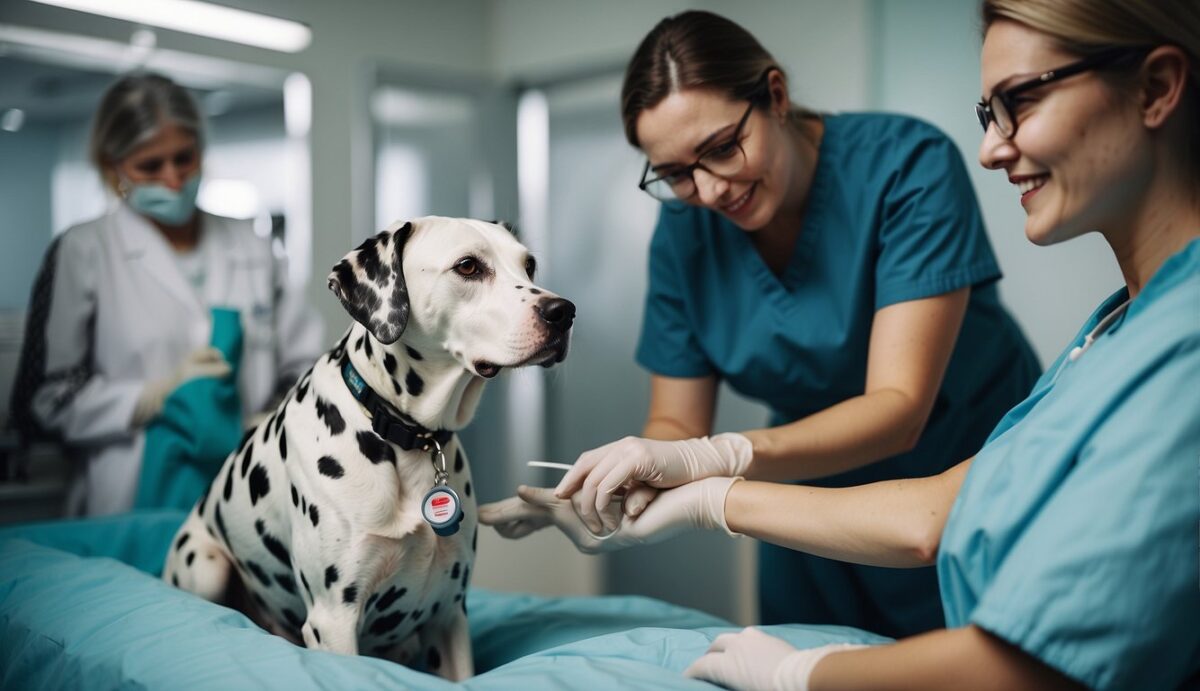Dalmatians are well-loved for their distinctive spotted coat and friendly nature, making them a popular choice for families. However, as with all breeds, they are prone to certain health issues, including cancer.
Understanding the common types of cancer that can affect Dalmatians is important for early detection and effective treatment.
Skin cancers like malignant melanoma, squamous cell carcinoma, and mast cell tumors are particularly prevalent, along with bone cancer such as osteosarcoma. Notably, these cancers can affect Dalmatians of all ages.
Recognizing the warning signs of cancer early can be life-saving.
Symptoms might include changes in appetite, weight loss, and difficulty with eating, along with altered bathroom habits and signs of pain.
Should you notice any persistent changes in your Dalmatian’s health or behavior, it’s crucial to consult your veterinarian.
Timely diagnosis and appropriate staging of cancer pave the way for a variety of treatment options.
Depending on the type and stage of cancer, treatments may include surgery, chemotherapy, radiation, or a combination of these, always aiming to improve quality of life.
Key Takeaways
- Learn about common cancers in Dalmatians and their early warning signs.
- Consult a veterinarian at the onset of symptoms for proper diagnosis and treatment.
- Multiple treatment options are available to manage cancer in Dalmatians and improve their quality of life.
Understanding Dalmatian Breeds and Their Health

When you consider bringing a Dalmatian into your life, awareness of their unique health characteristics is crucial for their well-being.
Dalmatians, famous for their spotted coats and friendly disposition, come with breed-specific health matters that require special attention.
Breed Overview and Genetic Predisposition
Dalmatians are a distinct purebred dog known for their high energy levels and friendly nature.
Purebred dogs like Dalmatians can be susceptible to genetic predispositions due to their breeding lineage. This means they can inherit certain hereditary health problems that are more common in their breed than in mixed-breed dogs.
Health Problems that are genetic or hereditary can be perpetuated by breeding practices.
For example, Dalmatians are particularly prone to congenital deafness, which can be attributed to a genetic mutation. Approximately 30% of Dalmatians are affected by hearing loss to some degree. To minimize these risks, responsible breeding practices and genetic screening are vital.
Common Health Problems in Dalmatians
- Deafness: A significant concern is congenital deafness, which may be detected through BAER testing.
- Urinary Stones: Another issue specific to Dalmatians involves their urinary system.
They have a unique uric acid metabolism that predisposes them to the formation of urinary stones, which can lead to discomfort and require dietary management or even surgery.
- Skin Conditions: Some skin tumors, like cutaneous Hemangioma, can occur, though benign.
Additionally, Dalmatians may develop skin issues such as solar keratitis due to sun exposure. Dalmatian bronzing syndrome, also known as “Dal crud,” is another condition leading to skin discoloration and hair loss.
Careful monitoring of your Dalmatian’s health and regular veterinary check-ups can help detect and manage these conditions effectively.
Simple preventive measures, like shade and sunscreen, can protect against solar keratitis, while a diet low in purines can help manage the risk of urinary stones.
Cancer in Dalmatians: An Overview

Cancer in Dalmatians can present various types and requires close attention to warning signs for early detection and treatment.
As you explore this concern, it’s vital to understand its prevalence, the different types, and how it progresses in these dogs.
Prevalence and Types of Cancer
Dalmatians, like all dog breeds, are susceptible to cancer, which can affect various parts of their bodies. Here are some cancer types your Dalmatian might encounter:
- Skin Cancer: This includes malignant melanoma, squamous cell carcinoma, and mast cell tumors, which can appear as abnormal growths on the skin.
- Bone Cancer (Osteosarcoma): Often develops in the limbs and is a common type of cancer in larger breeds.
- Hemangiosarcoma: Originates in the blood vessels and is known for its aggressiveness and potential to metastasize.
- Lymphoma: Affects the lymph nodes and other organs in the body, leading to a systemic disease.
As you monitor your Dalmatian, any persistent abnormal growth or change in behavior should prompt a visit to the vet.
Cancer Progression and Metastasis
Understanding how cancer progresses and the possibility of metastasis is crucial for managing your pet’s health. Here’s what you should know:
Metastasis is when cancer cells break away from the primary tumor and spread to other body parts, typically via the lymphatic system or bloodstream.
- Malignant tumors are cancerous and can metastasize, putting other organs at risk.
- Benign tumors, while not cancerous, may still require attention if they grow large enough to cause discomfort or functional issues.
Being proactive with regular vet check-ups and monitoring your Dalmatian for any signs of illness can help in early detection, potentially improving outcomes if cancer is diagnosed.
Recognizing the Warning Signs and Symptoms

Understanding the early warning signs and symptoms of Dalmatian cancer can be crucial for timely intervention and treatment. Knowing what to look for can help you catch cancer in its initial stages when treatment may be more effective.
Early Detection Through Signs and Symptoms
- Lumps and Bumps: You might notice a lump or mass on your Dalmatian’s skin that wasn’t there before. Not all lumps are cancerous, but any new growth warrants attention.
- Skin Changes: Look out for any sores that won’t heal, bleeding, or changes in the color or texture of your Dalmatian’s skin or gums.
Behavioral Changes:
- Lethargy: If your usually active Dalmatian seems unusually tired or less playful, it might be a sign of discomfort or pain.
- Weight Loss: Sudden weight loss without changes in diet can be a troubling sign.
- Exercise Intolerance: Watch for signs that your dog tires more easily during exercise or is more reluctant to engage in physical activity.
Other Symptoms to Monitor:
- Coughing or Difficulty Breathing: Persistent coughing or a noticeable difficulty in breathing can be associated with lung cancer or cancer that has spread to the lungs.
- Seizures or Weakness: Seizures, unexpected collapses, or general weakness can be associated with brain tumors or systemic illness.
- Signs of Pain: Dalmatians may exhibit signs of pain such as reluctance to be touched, whimpering, or changes in posture.
When to Seek Veterinary Care
If you observe any of the following in your Dalmatian, contact your veterinarian promptly:
- Persistence of Symptoms: Symptoms that persist or worsen over time, like a cough that doesn’t clear up or ongoing weight loss.
- New or Worsening Lumps: Any new lumps or changes in existing ones, including size increase or changes in texture.
- Significant Behavioral Changes: Drastic changes in behavior, such as sudden aggression or withdrawal, can indicate that your dog is in pain or distress.
Diagnosis and Staging of Cancer

Diagnosing and staging cancer in Dalmatians involves specific medical techniques to determine the presence, size, and spread of tumors. The correct diagnosis and staging are crucial for developing an effective treatment plan.
Utilizing Imaging and Biopsy Techniques
To diagnose cancer in your Dalmatian, veterinarians rely on a combination of imaging tests and biopsy procedures.
- Imaging Techniques:
- X-rays: Used for initial evaluation of tumors.
- Ultrasound: Helps in examining soft tissue structures.
- MRI (Magnetic Resonance Imaging): Provides detailed images of soft tissues.
- CT Scan (Computed Tomography): Combines multiple X-ray images for a comprehensive view.
- Biopsy Procedures:
- Fine-Needle Aspirate: Involves using a thin needle to collect cells for examination.
- Tissue Biopsy: A small sample of tissue is removed for more detailed analysis.
These tests help confirm the presence of cancer and may also provide insight into the type of cancer your pet is facing.
Staging and its Importance in Treatment Planning
Staging is the process of determining how far cancer has spread within your Dalmatian’s body. This crucial step guides the treatment approach and helps in predicting outcomes.
- Common Stages:
- Stage I: Cancer is localized to the site of origin.
- Stage II: Cancer is locally invasive.
- Stage III: Cancer has spread to regional lymph nodes.
- Stage IV: Cancer has spread to distant sites within the body.
A Chest X-ray may be conducted to check for metastasis to the lungs, which is a key factor in staging.
Treatment Options for Dalmatians with Cancer

When your Dalmatian is diagnosed with cancer, understanding the treatment options is crucial for making informed decisions. The right choice could significantly affect your pet’s quality of life and survival odds.
Surgical Intervention and Its Role
Surgery is often the first line of defense against cancer in Dalmatians, particularly when the tumor is localized and can be removed without significant risk to your dog’s health.
Post-surgery, it’s important to follow your vet’s recommendations for your dog’s recovery. This may include exercise restrictions and wound care.
Chemotherapy and Radiation Therapy
Chemotherapy and radiation therapy are common treatments that can be used on their own or in combination with surgery.
Chemotherapy involves the use of drugs to destroy cancer cells, while radiation targets specific areas with high-energy beams.
Your vet will work to find the most accurate treatment plan suited for your Dalmatian’s type of cancer.
- Chemotherapy may involve:
- A single drug or a combination of drugs.
- Administration through injections or oral medications.
- Radiation Therapy typically involves:
- A series of treatments over several weeks.
- Close monitoring for side effects like skin irritation.
Emerging Treatments and Immunotherapy
New strides in cancer treatment are constantly being made, and immunotherapy is one such promising area.
This treatment helps boost your dog’s immune system to fight cancer more effectively. Though not available for all types of cancer, it’s worth discussing with your vet for its potential to improve survival rates and the overall health of your Dalmatian.
Supportive Care and Improving Quality of Life

Supportive care in the treatment of Dalmatian cancer focuses on enhancing your pet’s quality of life by managing symptoms and providing relief from the discomfort associated with the disease.
Pain Management and Palliative Care
Your Dalmatian’s comfort is paramount when dealing with cancer.
Pain management strategies include medications like non-steroidal anti-inflammatory drugs (NSAIDs) or opioids, which your vet may prescribe.
- Medications: Administer prescribed painkillers strictly according to the vet’s instructions to manage discomfort.
- Regular Assessments: Keep up with regular veterinary check-ups to ensure pain management effectiveness and adjust when necessary.
- Comfort Measures: Soft bedding or warming pads can soothe your dog’s discomfort.
Palliative care is also a critical component. It is about more than just end-of-life care; it’s a proactive approach that runs simultaneously with other treatments, aiming to improve your furry friend’s daily life despite the prognosis.
Diet and Lifestyle Adjustments
Adjusting your Dalmatian’s diet and lifestyle can significantly affect their wellbeing during cancer treatment. Here are some up-to-date recommendations for supporting your pet:
- Nutrition: Offer a balanced, nutritious diet that supports overall health and boosts your pet’s immune system.
- Incorporate Omega-3 fatty acids which can help reduce inflammation.
- Exercise: Gentle exercise tailored to your Dalmatian’s stamina can maintain muscle tone and stimulate their appetite.
- Short walks in a quiet and unpolluted environment may uplift your pet’s spirit.
- Environmental Factors: Limit your pet’s exposure to environmental stressors such as excessive noise or extreme temperatures.
Always consult with your veterinarian to create a tailored supportive care plan that suits your Dalmatian’s unique needs.
Remember, as a pet parent, your awareness, and willingness to adapt is key to improving the quality of life for your beloved companion during their treatment journey.
Preventive Measures and Risk Factor Management

In guarding against Dalmatian cancer, your focus should be on understanding the specific risk factors and managing them, along with committing to regular health check-ups.
Understanding and Managing Risk Factors
Your Dalmatian’s risk of developing cancer can be influenced by a variety of factors, including age and genetic predispositions.
However, you can help minimize the risks through vigilant management of environmental factors and pre-existing health conditions.
- Age: Older Dalmatians are at a higher risk. Always keep track of their age-related health changes.
- Environmental Factors: Reduce exposure to known carcinogens, such as second-hand smoke and harmful chemicals.
- Health Conditions: Monitor and treat any health issues promptly, as they may escalate the risk of cancer if left unchecked.
With a blend of vigilance and proactive intervention, you can create a safer environment for your furry friend.
Routine Check-Ups and Health Monitoring
Establishing a regular schedule for health check-ups is key in the early detection of cancer in Dalmatians.
A thorough physical exam can help spot the early warning signs that might go unnoticed.
- Check-Up Frequency: Aim for at least once a year, but more frequently for seniors or those Dalmatians with known risk factors.
- Physical Exam: During the exam, your vet should check for any abnormal lumps, skin changes, or signs of illness that could indicate cancer.
Aftercare and Monitoring for Recovered Pets

Proper aftercare and vigilant monitoring are crucial for your Dalmatian’s health after treatment for cancer.
Ensuring up-to-date follow-up appointments and knowing the signs of recurrence can significantly affect your pet’s survival and well-being.
Post-Treatment Follow-Up and Surveillance
After your Dalmatian completes cancer treatment, regular follow-up appointments are essential. These appointments typically include:
- Physical Examinations: Your vet will check for any signs of cancer returning or new health issues.
- Diagnostic Tests: Blood tests, X-rays, ultrasounds, or other imaging to detect metastasis.
- Assessment Schedules: Initially, these may be more frequent, often every few months.
Keep a record of your pet’s recovery progress and any new symptoms.
You should also have an up-to-date schedule for follow-ups – don’t wait for symptoms to appear before visiting the vet.
Coping with Recurrence or Metastasis
If cancer recurs or has metastasized, understand that it’s not a failure on your part; cancer can be unpredictable.
Here’s what to focus on:
- Early Detection: Note any changes in your pet’s health or behavior and report them to your vet immediately.
- Supporting Your Pet: Provide a comfortable space, proper nutrition, and love to help them cope with the treatment.
- Emotional Support for Pet Parents: It can be challenging, but remember you’re not alone. Support groups and counseling can be beneficial for you as well.
Frequently Asked Questions (FAQs)

When addressing the health of your Dalmatian, it’s vital to understand common cancers they may face, their symptoms, and treatment methods.
These FAQs touch on those critical points, providing concise answers to guide your care for your spotted friend.
What are the common types of skin cancer seen in Dalmatians?
Your Dalmatian can be affected by several common skin cancers, such as basal cell carcinoma, mast cell tumors, and melanomas.
Basal cell tumors are usually low-grade malignancies, while melanomas can be more aggressive and require prompt attention.
How can I spot the warning signs of skin cancer in my dog?
Be vigilant for unusual changes in your dog’s skin, such as new lumps, bumps, or discolored spots that grow or change over time.
Skin lesions that do not heal, itch, or bleed could also signify cancer and warrant a veterinary check-up.
Are there particular skin cancer symptoms I should watch out for in my Dalmatian?
Specifically, in Dalmatians, pay close attention to any raised, firm masses that may suddenly appear on their skin or subcutaneous tissue.
As a breed with unique pigmentation, any alterations in their spots or new pigmented areas should be examined.
What kind of treatment options are available for dogs diagnosed with skin cancer?
Treatment varies depending on the type and stage of skin cancer but may include surgical removal of tumors, chemotherapy, radiation, or a combination of these.
Your vet may also discuss immunotherapy or targeted therapies based on your dog’s specific condition.
How do I know if my Dalmatian is suffering from cancer?
If you notice persistent symptoms such as weight loss, lethargy, or unexplained pain and swelling, these could be signs of cancer.
A veterinary examination can clarify the cause and set a course for treatment if necessary.
Is cancer treatment advisable for Dalmatians in their senior years, such as age 13 and older?
Cancer treatment decisions for older Dalmatians should weigh their overall health, life expectancy, and quality of life.
Your vet will provide a personalized recommendation, considering if the benefits of treatment will outweigh any potential risks for your senior companion.

